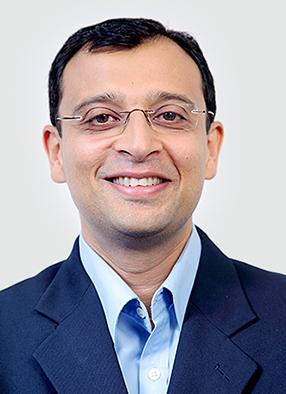
Chief marketers across business verticals are spreading their wings from the traditional role of marketing to new media to build new capabilities within. Marketer’s role has undergone a sea change over the last few years, and the most significant being that they rely more on data to derive insight and intelligence for the organisation.
So, the mandate for the new age CMO typically encompasses generating new revenue streams using digital skills – especially data analysis ability for the overall efficiency of the organisation. The driver of this change is the new generation of technology dedicated for marketers to be able to collate and decipher data with actionable insights.
“It’s because of demands from customers,” says Salil Godika, CMO, Happiest Minds Technologies. “Customers today are more tech savvy than ever. So, in a way, the marketing officer has no choice but to deploy technology to be able to track customers’ preferences and meet their demands accordingly,” adds Salil.
 Salil Godika, CMO, Happiest Minds
Salil Godika, CMO, Happiest Minds Meeting the increasing competitiveness
The CMO has always had a crucial role to play as he has to guide the strategy of an organisation to win the customers and market share – and drive profitable growth. With increasing competitiveness, the role obviously gets into more focus even in the industries that were hitherto not considered ’marketing savvy.’
“While digital is becoming all pervasive and a critical marketing tool for all organisations, we have to remember that digital marketing is a means to an end and not an end in itself,“ says Vivek Chandel, Executive Director, Marketing, Xerox India. ”It is a wonderful tool that allows the marketers to do their critical tasks – communicating and engaging with customers, getting customers’ feedback and insight, fulfillment of sales and service – in a very efficient way,” adds Vivek. But other elements of the mix also have a role to play.
The CMO has to look at the digital business as a part of the mix and ensure that all the elements work together as a whole to deliver the objectives. To better handle all these new ramifications, several companies have already hired someone called Chief Digital Officers (CDO).
CDO is an amalgamation of roles, which neither the CIO nor the CMO had in past. ”Quite a few of our customers are CDOs,” says Salil.”These CDOs are chartered directly by respective CEOs to take care of the digital transformation of their organisations,” adds Salil.
 Vivek Chandel, Executive Director, Marketing, Xerox India
Vivek Chandel, Executive Director, Marketing, Xerox India Close integration between IT and business
Since the CMO is a key stakeholder in a lot of IT investments; he needs to work very closely with the CIO in order to ensure these investments are made in the right technology and with business friendly interfaces and processes. The CMO and CIO have to understand the roles and perspectives of each other very clearly for this relationship to work.
“The CMO is the user who sets the expectations in terms of what he wants delivered for business. The CIO is his advisor who has to find the most efficient way to deliver what the business needs, sometimes even showing what more is possible,” says Vivek of Xerox. ”He also has to ensure that the solution is sustainable, the IT architecture is scalable and flexible for future needs and then delivers it most efficiently for the business,” adds Vivek.
“With digital marketing catching up and CMOs being at the digital side of all initiatives, the integration between CIOs and CMOs is more intertwining than ever,” says Anil Saini, COO (past CIO), Ricoh India.
”Close integration between IT and business is the need of the hour,” says Manoj Kumar, Group CIO, ACME. This simplifies the technology guy’s role of understanding of business and prescribing the right technology. “There are companies where CIOs report to CMOs” – and this is a good thing to have, adds Manoj.
 Manoj Kumar, Group CIO, ACME
Manoj Kumar, Group CIO, ACME CMOs taking up the challenge
A lot of IT investments are being made today in the areas like sales force automation, automated campaign management, data analytics for strategy and everyday decision making – essentially in customer/field sales facing functions and business decision making based on customer insights. These are clearly the areas where the CMO is the key stakeholder.
In fact Gartner says the CMO’s technology budget will exceed the CIO’s. This implies that the role of the CMO is getting redefined across the organisation which would require chief marketers to acquire a lot of new skills. ”The CMO therefore has to step-up his/her understanding of the latest options available and their pros and cons – to be able to give guidance for the right investments that deliver the right results and efficiency for the business,” says Vivek of Xerox India.
Essentially you need a CMO who is comfortable with technology, willing to try out new ideas to take his business to the next level, make it more efficient and to deliver a better customer experience.
, Ricoh India.jpg) Anil Saini, Ricoh India
Anil Saini, Ricoh India Cementing the synergy between CMOs and CIOs
All said and done. The change that is required today is a close synergy between CMO and CIO to be able to transform their organisation. Since the CMO is a key stakeholder in a lot of IT investments, he needs to work very closely with the CIO – in order to ensure these investments are made in the right technology and with business friendly interfaces and processes. The CMO and CIO have to understand the roles and perspectives of each other very clearly for this relationship to work. The CMO sets a business goal and the CIO gets a sustainable, scalable solution – and then the duo jointly delivers it most efficiently to their business.

 In
In
Add new comment